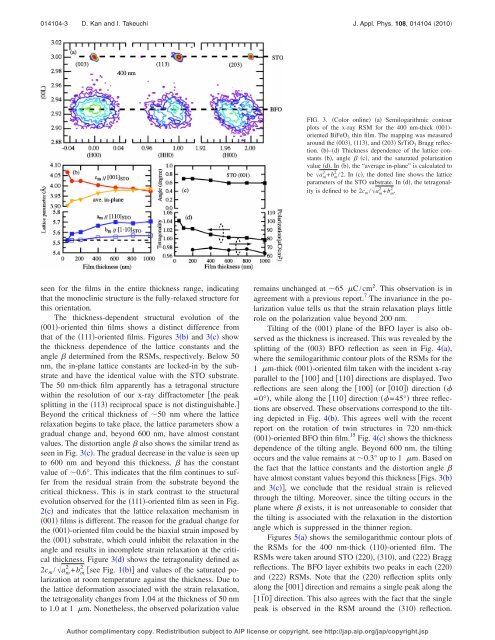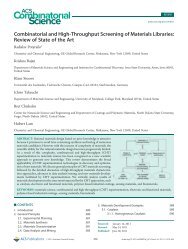Effect of substrate orientation on lattice relaxation of epitaxial ...
Effect of substrate orientation on lattice relaxation of epitaxial ...
Effect of substrate orientation on lattice relaxation of epitaxial ...
You also want an ePaper? Increase the reach of your titles
YUMPU automatically turns print PDFs into web optimized ePapers that Google loves.
014104-3 D. Kan and I. Takeuchi J. Appl. Phys. 108, 014104 2010<br />
FIG. 3. Color <strong>on</strong>line a Semilogarithmic c<strong>on</strong>tour<br />
plots <str<strong>on</strong>g>of</str<strong>on</strong>g> the x-ray RSM for the 400 nm-thick 001oriented<br />
BiFeO 3 thin film. The mapping was measured<br />
around the 003, 113, and 203 SrTiO 3 Bragg reflecti<strong>on</strong>.<br />
b–d Thickness dependence <str<strong>on</strong>g>of</str<strong>on</strong>g> the <strong>lattice</strong> c<strong>on</strong>stants<br />
b, angle c, and the saturated polarizati<strong>on</strong><br />
value d. Inb, the “average in-plane” is calculated to<br />
be am 2 +b m 2 /2. In c, the dotted line shows the <strong>lattice</strong><br />
parameters <str<strong>on</strong>g>of</str<strong>on</strong>g> the STO <str<strong>on</strong>g>substrate</str<strong>on</strong>g>. In d, the tetrag<strong>on</strong>ality<br />
is defined to be 2c m / am 2 +b m 2 .<br />
seen for the films in the entire thickness range, indicating<br />
that the m<strong>on</strong>oclinic structure is the fully-relaxed structure for<br />
this <str<strong>on</strong>g>orientati<strong>on</strong></str<strong>on</strong>g>.<br />
The thickness-dependent structural evoluti<strong>on</strong> <str<strong>on</strong>g>of</str<strong>on</strong>g> the<br />
001-oriented thin films shows a distinct difference from<br />
that <str<strong>on</strong>g>of</str<strong>on</strong>g> the 111-oriented films. Figures 3b and 3c show<br />
the thickness dependence <str<strong>on</strong>g>of</str<strong>on</strong>g> the <strong>lattice</strong> c<strong>on</strong>stants and the<br />
angle determined from the RSMs, respectively. Below 50<br />
nm, the in-plane <strong>lattice</strong> c<strong>on</strong>stants are locked-in by the <str<strong>on</strong>g>substrate</str<strong>on</strong>g><br />
and have the identical value with the STO <str<strong>on</strong>g>substrate</str<strong>on</strong>g>.<br />
The 50 nm-thick film apparently has a tetrag<strong>on</strong>al structure<br />
within the resoluti<strong>on</strong> <str<strong>on</strong>g>of</str<strong>on</strong>g> our x-ray diffractometer the peak<br />
splitting in the 113 reciprocal space is not distinguishable.<br />
Bey<strong>on</strong>d the critical thickness <str<strong>on</strong>g>of</str<strong>on</strong>g> 50 nm where the <strong>lattice</strong><br />
relaxati<strong>on</strong> begins to take place, the <strong>lattice</strong> parameters show a<br />
gradual change and, bey<strong>on</strong>d 600 nm, have almost c<strong>on</strong>stant<br />
values. The distorti<strong>on</strong> angle also shows the similar trend as<br />
seen in Fig. 3c. The gradual decrease in the value is seen up<br />
to 600 nm and bey<strong>on</strong>d this thickness, has the c<strong>on</strong>stant<br />
value <str<strong>on</strong>g>of</str<strong>on</strong>g> 0.6°. This indicates that the film c<strong>on</strong>tinues to suffer<br />
from the residual strain from the <str<strong>on</strong>g>substrate</str<strong>on</strong>g> bey<strong>on</strong>d the<br />
critical thickness. This is in stark c<strong>on</strong>trast to the structural<br />
evoluti<strong>on</strong> observed for the 111-oriented film as seen in Fig.<br />
2c and indicates that the <strong>lattice</strong> relaxati<strong>on</strong> mechanism in<br />
001 films is different. The reas<strong>on</strong> for the gradual change for<br />
the 001-oriented film could be the biaxial strain imposed by<br />
the 001 <str<strong>on</strong>g>substrate</str<strong>on</strong>g>, which could inhibit the relaxati<strong>on</strong> in the<br />
angle and results in incomplete strain relaxati<strong>on</strong> at the critical<br />
thickness. Figure 3d shows the tetrag<strong>on</strong>ality defined as<br />
2c m / am 2 +b m 2 see Fig. 1b and values <str<strong>on</strong>g>of</str<strong>on</strong>g> the saturated polarizati<strong>on</strong><br />
at room temperature against the thickness. Due to<br />
the <strong>lattice</strong> deformati<strong>on</strong> associated with the strain relaxati<strong>on</strong>,<br />
the tetrag<strong>on</strong>ality changes from 1.04 at the thickness <str<strong>on</strong>g>of</str<strong>on</strong>g> 50 nm<br />
to 1.0 at 1 m. N<strong>on</strong>etheless, the observed polarizati<strong>on</strong> value<br />
remains unchanged at 65 C/cm 2 . This observati<strong>on</strong> is in<br />
agreement with a previous report. 7 The invariance in the polarizati<strong>on</strong><br />
value tells us that the strain relaxati<strong>on</strong> plays little<br />
role <strong>on</strong> the polarizati<strong>on</strong> value bey<strong>on</strong>d 200 nm.<br />
Tilting <str<strong>on</strong>g>of</str<strong>on</strong>g> the 001 plane <str<strong>on</strong>g>of</str<strong>on</strong>g> the BFO layer is also observed<br />
as the thickness is increased. This was revealed by the<br />
splitting <str<strong>on</strong>g>of</str<strong>on</strong>g> the 003 BFO reflecti<strong>on</strong> as seen in Fig. 4a,<br />
where the semilogarithmic c<strong>on</strong>tour plots <str<strong>on</strong>g>of</str<strong>on</strong>g> the RSMs for the<br />
1 m-thick 001-oriented film taken with the incident x-ray<br />
parallel to the 100 and 110 directi<strong>on</strong>s are displayed. Two<br />
reflecti<strong>on</strong>s are seen al<strong>on</strong>g the 100 or 010 directi<strong>on</strong> <br />
=0°, while al<strong>on</strong>g the 110 directi<strong>on</strong> =45° three reflecti<strong>on</strong>s<br />
are observed. These observati<strong>on</strong>s corresp<strong>on</strong>d to the tilting<br />
depicted in Fig. 4b. This agrees well with the recent<br />
report <strong>on</strong> the rotati<strong>on</strong> <str<strong>on</strong>g>of</str<strong>on</strong>g> twin structures in 720 nm-thick<br />
001-oriented BFO thin film. 15 Fig. 4c shows the thickness<br />
dependence <str<strong>on</strong>g>of</str<strong>on</strong>g> the tilting angle. Bey<strong>on</strong>d 600 nm, the tilting<br />
occurs and the value remains at 0.3° up to 1 m. Based <strong>on</strong><br />
the fact that the <strong>lattice</strong> c<strong>on</strong>stants and the distorti<strong>on</strong> angle <br />
have almost c<strong>on</strong>stant values bey<strong>on</strong>d this thickness Figs. 3b<br />
and 3c, we c<strong>on</strong>clude that the residual strain is relieved<br />
through the tilting. Moreover, since the tilting occurs in the<br />
plane where exists, it is not unreas<strong>on</strong>able to c<strong>on</strong>sider that<br />
the tilting is associated with the relaxati<strong>on</strong> in the distorti<strong>on</strong><br />
angle which is suppressed in the thinner regi<strong>on</strong>.<br />
Figures 5a shows the semilogarithmic c<strong>on</strong>tour plots <str<strong>on</strong>g>of</str<strong>on</strong>g><br />
the RSMs for the 400 nm-thick 110-oriented film. The<br />
RSMs were taken around STO 220, 310, and 222 Bragg<br />
reflecti<strong>on</strong>s. The BFO layer exhibits two peaks in each 220<br />
and 222 RSMs. Note that the 220 reflecti<strong>on</strong> splits <strong>on</strong>ly<br />
al<strong>on</strong>g the 001 directi<strong>on</strong> and remains a single peak al<strong>on</strong>g the<br />
11¯0 directi<strong>on</strong>. This also agrees with the fact that the single<br />
peak is observed in the RSM around the 310 reflecti<strong>on</strong>.<br />
Author complimentary copy. Redistributi<strong>on</strong> subject to AIP license or copyright, see http://jap.aip.org/jap/copyright.jsp












